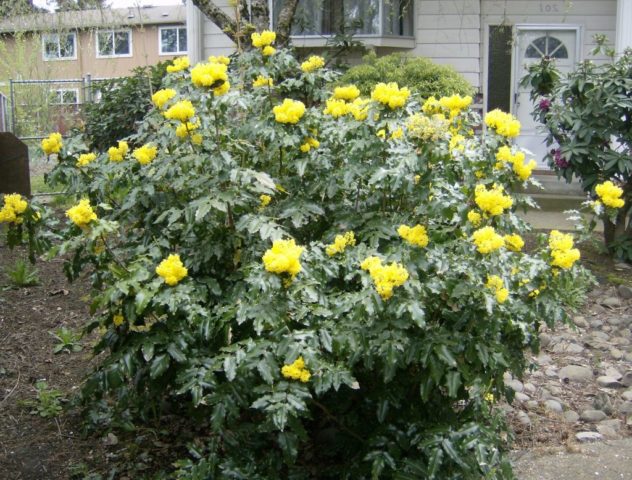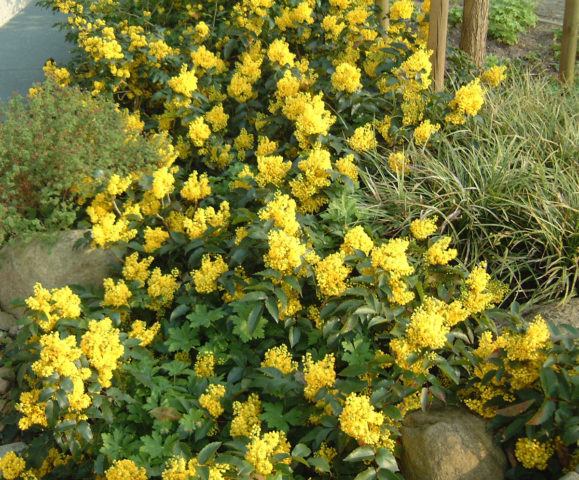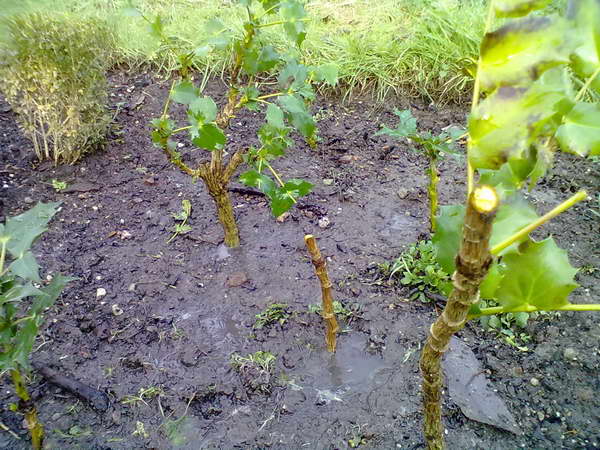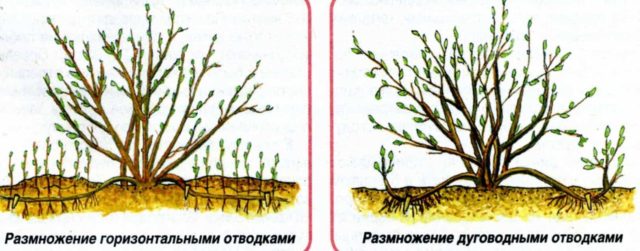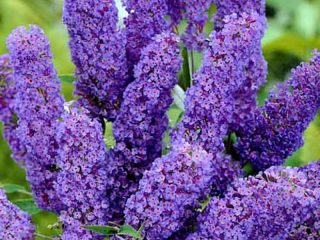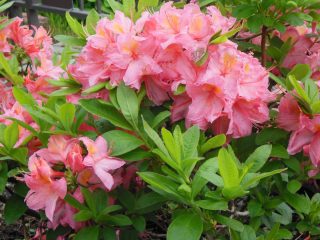Content
Planting and caring for holly mahonia is not rich in any special features, because the culture is undemanding to the place and growing conditions. An ornamental shrub native to North America was named after the gardener B. McMahon, who first described the local species at the beginning of the 19th century. Mahonia from the American continent received the second definition due to the similarity of the leaves to holly. The genus Mahonia, which belongs to the Barberry family, has other species that grow in their natural range in the central and eastern regions of Asia.
Description of holly mahonia
An evergreen shrub, known by the Latin name mahonia aquifolium, or holly mahonia, grows between 0.8-1.2 m. On fertile soil in the southern regions it rises higher. The crown of the bush is dense and also grows luxuriantly - up to 1.2-1.5 m. The root system of Mahonia is developed, the shoots penetrate deep into the soil to provide the branches and leathery leaves with the necessary amount of moisture and nutrients. Most varieties of holly mahonia have an erect trunk, without thorns. The shade of gray bark of the shoots changes color as it develops. Young trunks of mahonia are pinkish, old ones acquire a brown tone, especially in winter, standing out against the background of green foliage.
The leaves of the holly shrub are pinnately complex, up to 20 cm long, consist of 5-9 small leaf blades shiny on top on short red petioles, approximately 2.5-3x8 cm in size, dense, leathery, beautiful elliptical in shape. The edges are jagged, with small but sharp spines. The emerald greenery of the holly-leaved species persists in winter if the bush grows in the shade. In autumn, especially in the sun, the color of the leaves changes from reddish to a dark bronze shade. When planting mahonia holly in an open and sunny place, care includes shading at the end of winter and spring so that the leaves do not burn in direct rays. The leaves suffer in the sun and in the summer, in the southern regions, brown spots appear on them.
How holly mahonia blooms
An ornamental evergreen shrub blooms buds in different regions from mid-April or May. The bright, long-lasting flowering of Mahonia can be admired until the end of May, beginning of June. Small buds of 6 petals are formed at the tops of the branches.Mahonia flowers, as seen in the photo, are 7-8 mm in size, collected in large panicles that branch widely, creating lush yellow caps. Near the bush you can feel an original floral-honey aroma. After 1.5-2 months, small edible blue-violet berries ripen; they look just as picturesque, especially against the background of reddening leaves.
Types and varieties
The holly-leaved species of mahonia has several varieties:
- nut-leaved, characterized by denser leaf blades;
- graceful, characterized by elongated, narrow leaves;
- golden, with a light tint on the foliage;
- variegated, with varying shades of leaves.
Foreign gardeners have developed many varieties of mahonia holly, but most of them are designed for mild winters with small and short-term sub-zero temperatures:
- Autropurpurea;
- Moseri;
- Flame;
- Foreskate;
- Versicolor and others.
The Apollo and Smaragd varieties are suitable for the conditions of central Russia. Seedlings of these varieties of mahonia in Siberia and the Urals also take root with proper care, primarily with shelter for the winter during the first 5 years.
Mahonia Apollo
Mahonia holly cultivar Apollo is a slow-growing shrub, by the age of 10 it rises only 55-60 cm. It is distinguished by red bark on thorny shoots, which droop greatly as they grow. The Apollo bush is unpretentious to soils, but is very moisture-loving, suffers from prolonged heat, and requires nightly sprinkling in such conditions. The flowers are orange-yellow. An adult plant overwinters without shelter.
Mahonia Smaragd
The Smaragd bush has straight shoots. The height of the holly mahonia variety Smaragd is small, up to 70 cm. The seedling is low, only up to 30 cm. The leaves are bright emerald color, copper-colored in winter and spring.Prefers moist, loose and fertile soils. The bush quickly recovers after freezing of individual branches.
How to propagate holly mahonia
The unpretentious shrub reproduces in different ways:
- layering;
- shoots;
- cuttings;
- seeds.
Propagation by cuttings of holly mahonia
Mahonia cuttings are carried out in the summer, from early June to August. Cut off the shoots of the current year, which have fully formed leaves:
- then the branches are divided into fragments so that each has a bud at the top and bottom;
- the lower bud is located 2-3 cm from the cut;
- The top shoot is cut straight, and the bottom edge is cut diagonally.
Mahonia cuttings are treated with any growth stimulant, checking the instructions. For the substrate, prepare peat half with sand. The top of the container with the planted mahonia cuttings is covered with film. For rooting, the substrate is kept moist, the film is opened once a day, the air temperature is not lower than 20 °C. Roots form in 50-60 days. The seedlings are placed in individual containers, maintaining high air humidity.
Gardeners suggest that roots can form after approximately the same time on those branches of mahonia that were used for New Year's decor. Only they are placed one at a time in a vase, changing the water.
Propagation by seeds of holly mahonia
This method is labor-intensive and time-consuming: mahonia bushes grown from seeds will bloom in 5 years. The seeds are collected from the berries. It is better to immediately sow them in prepared furrows, mark the area and cover with leaves.With this method, natural stratification will occur. If dry seeds are available, but it is too late to sow in the ground due to frost, they are placed in a prepared substrate in a container. The container is placed in the refrigerator for 60-100 days. In March, the container is removed, placed on a warm windowsill and awaited for germination.
In May and early June, the sprouts are transplanted to a fenced area, where they will develop for a year or two.
How to propagate by dividing a bush
The method of dividing the roots is the easiest, because a well-established bush over 9 years old appears new growth every year. Lack of shoots - weak, undeveloped roots. Therefore, after separating the shoot from the central root, it is necessary to apply a growth stimulator.
Rules for propagation by layering
A new mahonia plant begins to form in the spring:
- choose the lower healthy branch;
- carefully scrape off the bark in 2-3 places, which promotes root formation;
- lay the mahonia shoot in a groove prepared in advance with a depth of 8-11 cm and secure it with a garden clamp;
- the top is usually brought to the surface, and the groove is covered with soil.
The area is kept clean and constantly watered. Sprouts appear in July-August. They are separated from the mother bush of mahonia the next year or every other season.
Planting and caring for mahonia in open ground
Only frost-resistant varieties of holly-leaved mahonia are purchased for the garden.
When can you plant mahonia: in spring or autumn
The holly species in the middle zone is planted in the spring. In the south, it is better to plant in the fall, before mid-November. Spring planting can be complicated by a dry and hot spring, when the evergreen young shrub will not have enough moisture.Mahonia is often purchased from nurseries in containers, from which the shrub is moved in the summer. But in this case, the plant is planted in the shade.
Site selection and soil preparation
Judging by the photo and description of the shrub, mahonia holly is planted in the sun. In the southern regions, most often in semi-shaded places, where there is openwork protection from direct sunlight at midday. Such an exposure corresponds to the natural growing conditions of the species, which spreads on the “lower floor” of the deciduous forest. The soil in such an eco-environment is light, loose, rich in rotted remains of leaves. The fertile composition of slightly acidic sandy loams or loams will contribute to the development of holly mahonia. The shrub does not tolerate stagnant water and alkaline soils. The site, or at least the planting hole, must be well drained and the collected water mass must be drained after rains or snow melting.
How to plant mahonia correctly
When creating a hedge of mahonia, holes are marked at intervals of 90 cm. And in compositions with mahonia holly, according to the description and photo, they retreat from other crops to 1.5-2 m. To enrich the substrate, a hole is dug some time before planting. The size should be sufficient to add 1 part of manure humus and 2 parts of rotted leaf litter to the soil - 60 cm deep and in diameter. The substrate is mixed with 5-7 g of any complex fertilizer such as nitrophoska per 1 liter of soil. On heavy soils, a drainage layer of up to 10-15 cm is arranged at the bottom. When planting, the shrub is placed so that the root collar is at the same level with the garden soil.Having filled the hole, the soil is compacted, watered, and then mulched around the perimeter of the entire tree trunk circle.
Caring for mahonia after planting
Planting holly leaves in the right place and following the recommendations is already half the success in growing ornamental shrubs. Mahonia is cared for like most other garden crops. The tree trunk circle without mulch is regularly loosened a day after watering, and weeds are removed near the seedling. Under an old, densely branched bush, as a rule, no grass grows through.
Watering
Caring for mahonia in open ground includes mandatory watering of the seedling. In the first summer, a young bush is watered every 3-4 days if there is no precipitation. According to its characteristics, the holly species is drought-resistant; an adult plant can withstand 14-15 days without watering. At one time, 15-20 liters of water are used on the mahonia holly bush so that the soil is moistened to the roots. In case of prolonged drought, evergreen leaves are washed every evening or 2-3 times a week by sprinkling, using a hose with a diffuser. It is especially recommended to carry out such watering in the southern regions.
Top dressing
If organic matter is present, humus is used to mulch the bush in the fall, while simultaneously providing it with nutrition. In the spring, any complex mineral fertilizer NPK is applied to the holly mahonia, which contains enough nitrogen for growth and potassium for the formation of buds. For the perimeter of the trunk circle, which for a seedling is approximately 1 square. m, scatter 100 g of granules or dissolve in water, following the instructions.Since mid-September, mahonia holly has been fed with potassium-phosphorus preparations, using potassium monophosphate, potassium magnesia, superphosphate and other means.
Mulching
Holly-leaved seedlings are mulched in the first season. The procedure helps:
- retain moisture in the soil;
- prevents weed germination;
- By reheating, it replenishes the reserves of nutrients in the soil.
For mulch, take dry leaves, sawdust, peat, crushed bark, dry or freshly cut grass without seeds. The old layer of mulch is not thrown away; a new one is placed on it.
Pruning holly mahonia
Sanitary cleaning is carried out every autumn and spring, removing:
- damaged branches;
- shoots that grow inside the crown;
- thin and weak shoots that extend from the bottom of the trunk.
A dense crown and lush flowering are formed by pruning:
- in the first season after planting, the tops of the shoots are cut off to stimulate branching, leaving 10-20 cm from the root;
- next spring, shorten the grown shoots by half;
- Mahonia is cut off when the flowers fade;
- the old bush is rejuvenated by heavy pruning, leaving 30-40 cm of branches.
It is taken into account that the holly species blooms on last year’s branches. In an adult bush, only part of the shoots is cut, giving others the opportunity to bloom and delight with spectacular flowering.
Transplanting holly mahonia
If it is determined that the bush is planted in the wrong place, the plant is moved. The holly species tolerates transplantation well not only at a young age.The time for transferring the shrub is chosen in accordance with the weather of the region, avoiding too late autumn planting:
- in the southern regions from mid-September to early November;
- in the middle climate zone - in April, until the end of May.
Mahonia is persistent; if necessary, the bush is moved throughout the warm season, but ensure abundant watering. Feed a month after transfer. The rules for transplanting, preparing the pit and substrate are identical to the initial placement of shrubs on the site:
- Before transplanting, several hours before, the holly plant is watered abundantly around the perimeter of the trunk circle to form a natural earthen lump;
- dig in from all sides;
- then the bush is not pulled out, but the earthen ball is lifted from both sides with shovels and placed on the prepared burlap.
Under such transfer conditions, the roots are practically not affected. The plant will bloom and develop in a more comfortable place.
Diseases and pests
Decorative crops suffer little from various fungal diseases. But when placed in the garden next to plants where pathogens parasitize, the leaves of the mahonia holly shrub, as in the photo, also become infected. Possible diseases:
- phyllosticosis – brown spots appear on the leaves, which expand over time, infecting the entire bush and neighboring plants;
- stagonosporosis – which is determined by the appearance of oval spots with a dark edge along the edges of the leaves;
- powdery mildew characterized by a white coating that covers the leaves with a continuous veil;
- rust manifests itself as rounded reddish dots on the leaves, which spread to cover a large area.
With all infections, mahonia leaves wither, crumble, and flowering is poor.If spotting is not responded to by spraying, the bush may die completely.
Treatment with copper preparations or modern fungicides is used to treat mahonia:
- Bordeaux mixture;
- copper oxychloride;
- Oksikhom;
- Tsineb;
- Abiga Peak;
- Phthalan;
- Topsin-M and others.
Preventive maintenance is encouraged:
- avoid thickening in the garden;
- remove weeds;
- systematically spray crops that often suffer from fungal diseases;
- in the fall, leaves are collected and burned if diseases were noticed in the summer;
- carry out mandatory spring treatment of the garden with fungicides or conventional preparations containing copper.
Gardeners who grow holly mahonia note that pests that plague other plants are practically never found on the shrub.
Preparing holly mahonia for winter
The shrub, even in its persistent varietal form, has retained its genetic characteristics. North American winters, where various modern varieties of holly mahonia come from, are much milder than in the continental temperate climate of the central zone of our country. In addition, sometimes there is frost without snow cover, which negatively affects all crops, not just those of southern origin. Therefore, in the first 4-5 years, young bushes are covered in late autumn, after sub-zero temperatures have established.
Preparation for the cold season for mahonia begins with moisture-recharging irrigation, which is carried out at the end of September or October, according to the region. 30-40 liters of water are spent on the bush, then the tree trunk circle is mulched. As a bottom layer, you can put nutritious mulch - 4-5-month-old manure, half rotted. Peat and dry leaves are placed on top. The bush is covered with spruce branches or mats knitted from natural material.
Adult bushes are only mulched. And at the end of winter, when the bright sun appears, mahonia holly, as mentioned in the video, is covered with shading material. A mesh or agrotextile will keep the mahonia leaves from burning out.
Conclusion
Planting and caring for holly mahonia are similar to the agricultural techniques of other ornamental shrubs. Planted in a cozy place, protected from sharp northern winds, on fertile and loose soil, the plant will delight you with bright blooms and a delicate aroma year after year.
